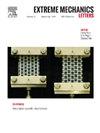GRCop-42金属微粒在极端冲击条件下的沉淀响应
IF 4.5
3区 工程技术
Q2 MATERIALS SCIENCE, MULTIDISCIPLINARY
引用次数: 0
摘要
GRCop-42是一种cu基合金,主要通过单个Cr2Nb相的沉淀硬化来强化。虽然其在准静态条件下的变形机制已经被广泛研究,但这些析出物在极端应变速率下的行为仍然知之甚少。在这项研究中,我们使用激光诱导微粒冲击测试(LIPIT)研究了GRCop-42粉末的高速率响应,其中单个合金颗粒以100至600 m/s的速度撞击纯Cu衬底。我们观察到在~ 490 ± 11 m/s的速度下从反弹到冲击诱导键的转变。结合颗粒的断面显微组织分析表明,虽然高应变速率冲击不会导致明显的析出相断裂或粗化,但析出相发生了形状变化。在较高的速度下,Cr2Nb析出物表现出增大的长径比,特别是在颗粒边缘附近。这种在沉淀尺度上的扁形变形归因于极端塑性变形驱动的绝热加热引起的局部温升。这种效应在较高的速度下更为明显,并且在空间上集中在颗粒-衬底界面的外围附近。本文章由计算机程序翻译,如有差异,请以英文原文为准。
Precipitate response in GRCop-42 metallic microparticles under extreme impact conditions
GRCop-42 is a Cu-based alloy strengthened primarily through precipitation hardening by a single Cr2Nb phase. While its deformation mechanisms under quasi-static conditions have been extensively studied, the behavior of these precipitates under extreme strain rates remains poorly understood. In this study, we investigate the high-rate response of GRCop-42 powder using laser-induced microparticle impact testing (LIPIT), where individual alloy particles are impacted onto a pure Cu substrate at velocities ranging from 100 to 600 m/s. We observe a transition from rebound to impact-induced bonding at ∼490 ± 11 m/s. Cross-sectional microstructural analysis of bonded particles reveals that, although high strain rate impact does not lead to significant precipitate fracture or coarsening, the precipitates undergo shape changes. At higher velocities, the Cr2Nb precipitates exhibit increased aspect ratios, particularly near particle edges. This oblate deformation at the precipitate scale is attributed to localized temperature rise from adiabatic heating, driven by extreme plastic deformation. The effect is more pronounced at higher velocities and is spatially concentrated near the periphery of the particle–substrate interface.
求助全文
通过发布文献求助,成功后即可免费获取论文全文。
去求助
来源期刊

Extreme Mechanics Letters
Engineering-Mechanics of Materials
CiteScore
9.20
自引率
4.30%
发文量
179
审稿时长
45 days
期刊介绍:
Extreme Mechanics Letters (EML) enables rapid communication of research that highlights the role of mechanics in multi-disciplinary areas across materials science, physics, chemistry, biology, medicine and engineering. Emphasis is on the impact, depth and originality of new concepts, methods and observations at the forefront of applied sciences.
 求助内容:
求助内容: 应助结果提醒方式:
应助结果提醒方式:


